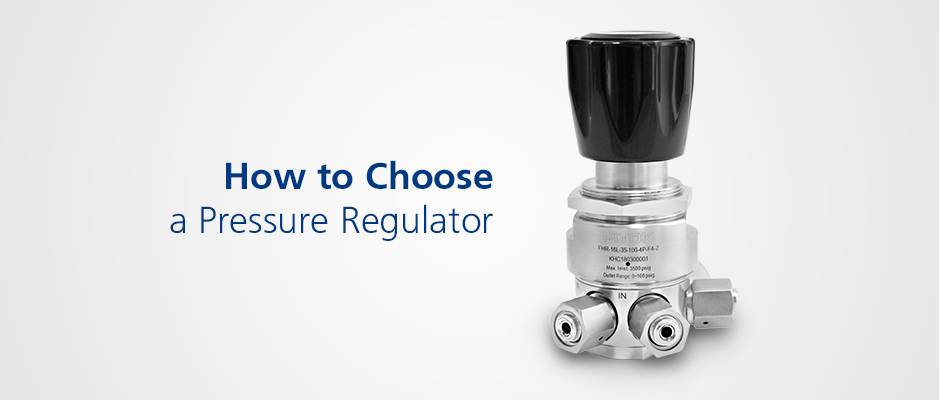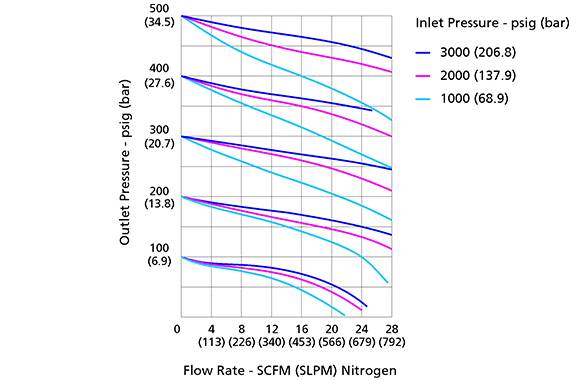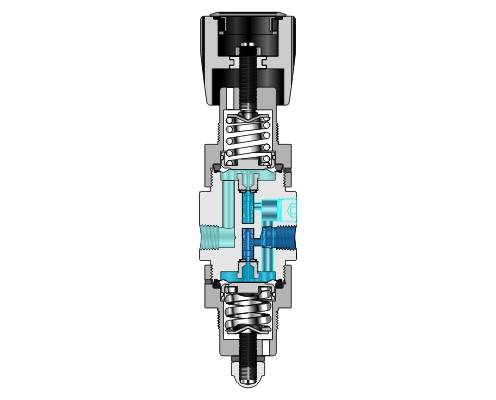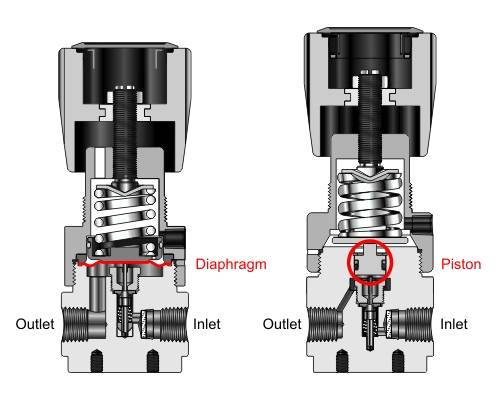How to Choose a Pressure Regulator

Pressure regulators play an important role in fluid systems for a variety of applications by reducing inlet pressure to a lower outlet pressure and keeping outlet pressure stable when inlet pressure fluctuates. Various factors need to be consider when selecting a pressure regulator, the most important of which include: flow, pressure, temperature, media and sensing mechanism.
Flow
The size of a pressure regulator is determine by the system flow. Selecting a properly sized pressure regulator facilitates its functional performance, and usually a larger pressure regulator allows for more reliable pressure control at higher flows. The following questions should be considered when selecting a pressure regulator: What is the maximum flow required? What is the flow variation range?

Pressure
Since the primary function of a pressure regulator is to reduce inlet pressure to a lower outlet pressure, it is critical to select a pressure regulator with proper maximum inlet pressure and outlet pressure control range. When the inlet pressure fluctuates significantly, and yet there is a higher requirement for accuracy and stability of outlet pressure, a dual-stage pressure regulator should be select to reduce the Supply Pressure Effect (SPE), such as FITOK FCR-1D Series Dual-stage Diaphragm Regulators, with only 0.01% SPE (SPE is 1% when the inlet pressure is below 500 psig).

Temperature
Pressure regulators are require to withstand expect operating temperatures, including ambient temperature, fluid temperature, and temperature changes due to the Joule-Thomson effect, which should be considered comprehensively when selecting a pressure regulator.
Media
Material compatibility between media and pressure regulators is critical as it determines the service life and performance of a pressure regulator. For example, when the medium is hydrogen, select pressure regulators made with FITOK enhanced -316/316L material in preference, whose Ni > 12% and Nieq ≥ 28.5%, thus achieving excellent resistance to hydrogen embrittlement.
Sensing Mechanism
Sensing mechanism is the component to separate the spring force from the fluid force. By sensing fluid pressure changes through the sensing mechanism, pressure regulators are able to respond to maintain the set pressure. Diaphragms and pistons are two main sensing mechanism types: diaphragm is more sensitive to pressure changes while piston is able to withstand higher pressure.

Due to the O-ring material, piston pressure regulators are not as clean and corrosion resistant as diaphragm pressure regulators. When there is a strict requirement for media cleanliness such as in the semiconductor and pharmaceutical industries, diaphragm pressure regulators are a more desirable choice. For example, FITOK FHR-1 Series High Performance High Purity Regulators with Hastelloy diaphragm sensing mechanism, can meet the requirement for media cleanliness in the semiconductor industry; while FCR-2 Series General Piston Regulators with piston sensing mechanism, can withstand inlet pressure up to 6,000 psig.
Conclusion
According to the requirements of the application scenario, full consideration of factors including flow rate, pressure, temperature, media and sensing mechanism will contribute to quick and right selection of pressure regulators.
User’s Guide
- Pressure regulators are sensitive components, so handle them gently and do not bump them.
- Pressure regulators with bottom mounting or panel mounting type available, when panel mounting is selected,handles of some series products need to be removed for installation. When removing the handle, ensure that the handle and stem positions are not changed, otherwise the outlet pressure range will not be the same as the factory setting.
- Before the pressure regulators are connected to the piping system, the system must be purged to remove impurities from the system, such as iron filings from tubing cutting or welding slag from tubing welding.
- If the media contain impurities, a filter must be installed upstream, otherwise the impurities will damage the pressure regulators, which will lead to the failure of the pressure regulating function of the pressure regulators and the continuous increase of downstream pressure. The downstream pressure will continue to rise and damage the downstream pressure gauge or other equipment. FITOK FT series 15 um filters are recommended.
- Do not allow any loose thread sealing tape or thread sealant to enter the pressure regulators when it is installed.
- Figure out the inlet and outlet when installing the pressure regulators.
- After the pressure regulators are connected to the pipeline, make sure that the pressure regulators are in the closed position by turning the handle before using the pressure regulators. For pressure regulators, turn the handle counterclockwise until it is loosened to the closed position.
- Check connections for leakage by applying leak detection fluid to all connections, turning the handle clockwise to set the outlet pressure to the desired pressure, and observing the connections for leakage.
- If the pressure regulators are used for liquid media, the filter element installed at the inlet of the pressure regulators may dog and cause a pressure drop and flow reduction. It is recommended to remove the filter element and install a filter upstream the inlet of the pressure regulators.
Installation Instructions and Cautions
- Before installing the pressure regulator, the pipeline must be purged to remove foreign matter and particles, such as remaining scrap iron from pipe cutting.

2. Filter must be installed upstream of the pressure regulator, otherwise system particles will damage the seat, causing internal leakage in the pressure regulator, increasing downstream pressure, and damaging the gauge or other equipment. FITOK FT series 15 μm filter is recommended and poppet in-line replacement is available.

3. Thread adhesive or liquid tape is not recommended for NPT thread installation, otherwise the filter in the pressure regulator may be blocked, resulting in no pressure at the outlet.

4. Turn the handle clockwise to increase outlet pressure and counterclockwise to reduce outlet pressure. The regulator handle can be in loose state when the outlet pressure is zero. Forcefully loose the handle may cause the stem thread stuck, then turn the handle clockwise, the stem will not move and the handle will fall off, resulting in unable to adjust pressure.
5. It is not recommended to use the pressure regulator for shutoff for a long time, otherwise the seat will deform, resulting in flow instability.
6. Handle with care and avoid any strike, especially for pressure regulator with gauge. The gauge is a sensitive element and external force may cause damage
For more information about pressure regulators, please see Pressure Regulator Selection Guide.



